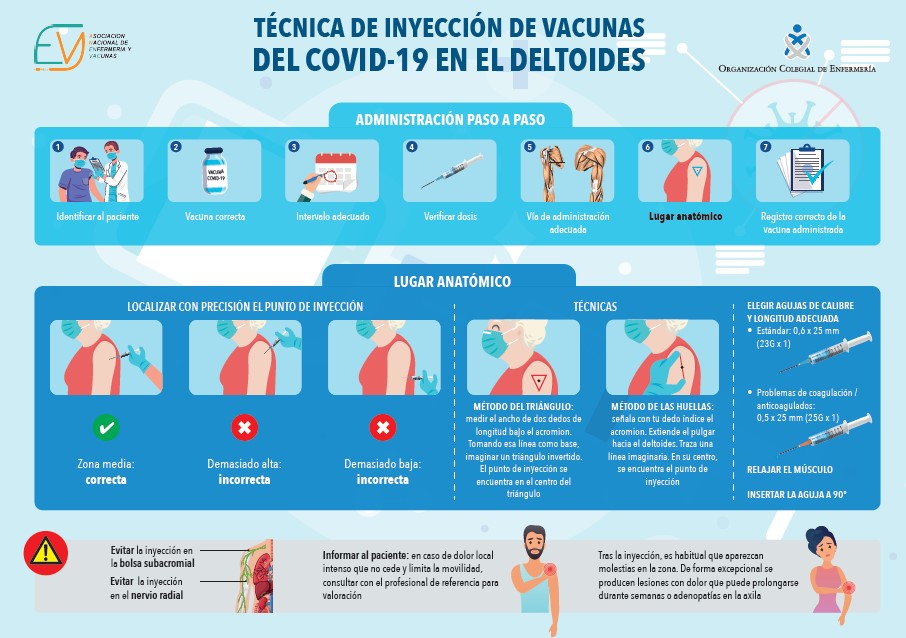During the vaccination campaign, many of the vaccinated people have side effects, among the most common is pain at the puncture site. The General Council of Nursing, in collaboration with the National Association for Nursing and Vaccines, has launched a new campaign in which he recalls step by step how the vaccine administration process should be, with special emphasis on the location of the injection site, essential to avoid the appearance of injuries or adverse reactions that can go further of a simple temporary local pain.
–
As Guadalupe Fontán, a nurse at the Research Institute of the General Nursing Council, explains, “the vaccination process is being carried out by the nurses in a very agile way.” In this sense, he insists on the importance of these professionals and not others who carry out the vaccination and it is that, in this process, “there are many steps that must be followed scrupulously”.
In addition, warns José Antonio Forcada, president of ANENVAC, “an incorrect technique or the application in inappropriate anatomical places can lead to injuries or more serious adverse reactions than usual. Therefore, vaccines should be administered only and exclusively by trained nurses with experience in vaccinations. It is not only about the act of pricking, the vaccination act includes a whole series of steps to guarantee the objectives of a vaccination, achieve immunity, avoid adverse effects and offer the highest quality in the intervention ”.
“Nurses,” he continues, “know perfectly the anatomy of the areas where we must proceed to administer vaccines, both in adults and in children and infants. Also the administration techniques (intramuscular, subcutaneous, intradermal) and in which anatomical areas each technique should be performed and the types of needles that should be used in each of them, according to the muscle mass of each person, etc. ”.
The infographic and video of this new campaign show all the steps, starting with identification until reaching the corresponding record in the vaccination card and medical history. In total, seven key steps, within which it stops at the exact location of the deltoid where the vaccine should be injected.
As José Antonio Forcada, president of ANENVAC, explains, “vaccines must be administered in the anatomical place where greater immunogenicity and less reactogenicity are achieved. In addition, it must be an area where the risk of producing any type of injury is minimal. For the administration of intramuscular vaccines in adults, the area of choice should be primarily the deltoid muscle, in its middle area, since the risk of injury to any nerve or vessel is minimal and very good immunogenicity is achieved with low reactogenicity ”.
Likewise, they are also detailed in other questions such as the appropriate choice of needles, in terms of gauge and length, the relaxation of the muscle by the patient and the anatomical areas in which it should not be punctured, such as the subacromial bag and the nerve. radial.
Adverse effects after injection
As is also explained in the information, it is common for discomfort in the area to arise after the injection, which subsides after a few days, however, it is also possible, although exceptionally, that there are painful injuries that persist for days. or lymphadenopathy in the armpit.
In this sense, Guadalupe Fontán points out, “it is very important that the population be informed that there is a local discomfort that occurs after the injection quite frequently.” This usually subsides after a few days and does not require specific attention. Furthermore, adds Fontán, “the technical sheets describe other types of postvaccinal reactions in which we have to be very careful because there may be inflammation or axillary adenopathy and pain that lasts for weeks and even limits mobility. In these cases, you should always consult with the healthcare professional of reference to assess it. In addition, it can generate a lot of uneasiness. For example, in women who have suffered from breast cancer, if they detect this axillary adenopathy, they may think of a recurrence, hence the importance of monitoring these symptoms and in the face of prolonged pain or limitation of mobility, you should always consult a professional reference”.
As for whether these injection-related adverse reactions differ between some vaccines and others, Forcada clarifies, “they are similar between the three currently available vaccines.” However, he points out, “mRNA vaccines produce a higher frequency and intensity of adverse reactions in the second dose, while in the adenovirus vaccine, the intensity and frequency is lower in the second dose.” And, on the other hand, there are differences according to the patient’s profile, thus, he stresses, “these reactions occur with greater frequency and intensity in young people than in older people.”
–


